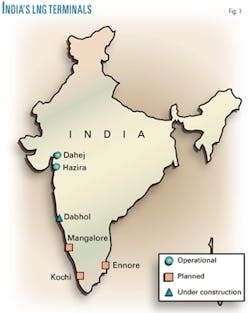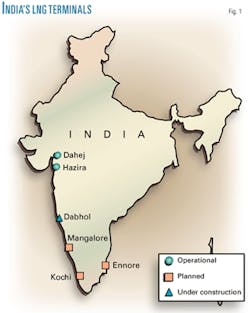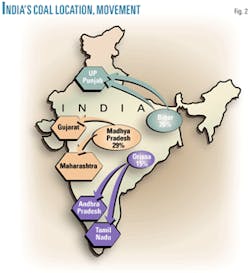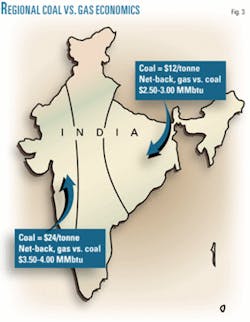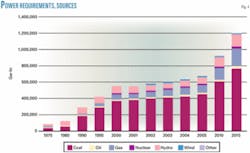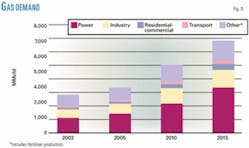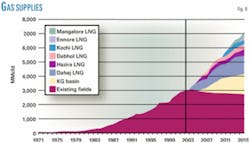The expansion of India’s economy over the next decade will push the country’s demand for natural gas beyond supply, but whether LNG can fill this supply gap is a function of both domestic and global economics. This second of two articles examines current and pending LNG projects as well as the effect of India’s natural gas pricing structure on their potential advancement.
The first article (OGJ, Dec. 19, 2005, p. 65) focused on the likelihood of meeting future demand through import pipeline projects and development of the country’s domestic pipeline infrastructure.
LNG could play an important role in reducing a future supply gap, especially in western India where the cost of coal is relatively high due to the distance from major coal fields in the eastern part of the country. Only three import terminals are either complete or under construction, but numerous proposals have been put forward for additional terminals.
Existing terminals
Dahej. LNG first flowed into India in January 2004 through Petronet LNG Ltd.’s 5-million tonne/year (tpy)Dahej terminal. Gas Authority of India Ltd., Oil and Natural Gas Corp., Indian Oil Corp., and Bharat Petroleum Corp. Ltd. make up Petronet. Gaz de France has taken 10% equity in the company as a strategic partner. The Asian Development Bank has 5% equity. Qatar’s RasGas Co. Ltd. supplies gas to Dahej. The gas is subsequently distributed through the Hazira-Bijaipur-Jagdishpur pipeline to consumers in Gujarat, Madhya Pradesh, Uttar Pradesh, Rajasthan, Haryana, and Delhi.
The terminal operated at half capacity in 2004, but Petronet exercised an option to obtain the fully contracted 5 million tpy from RasGas in 2005. Petronet plans to expand capacity to 10 million tpy by 2008.
Dabhol. The 5-million tpy Dabhol terminal is largely complete but still unused in the wake of the 2001 collapse of Enron Corp. The terminal was about 90% built when construction was halted in June 2001.The government recently mandated that GAIL revive the LNG facility and National Thermal Power Corp., the associated power plant. The terminal is to be operational by mid-2006. Potential buyers have expressed interest in the Dabhol LNG terminal due to the siting of the power plant and LNG terminal at the same facility.
Hazira. The first cargo of LNG arrived at the Shell-operated Hazira terminal (2.5 million tpy) in April 2005 from Australia’s Northwest Shelf development for subsequent sale to Gujarat State Petroleum Corp. Oman delivered the second cargo in June.
Hazira, unlike Dahej, does not focus on long-term contracts. LNG will initially be delivered under short-term arrangements from Shell projects in Australia, Oman, Qatar, and elsewhere. Total recently bought a 26% stake in Hazira, potentially widening its source options.
Shell plans to combine the regasification facility with a container terminal to improve economics, using the facility for tolling and selling gas on a short-term basis. Shell, however, is also discussing the potential supply of gas to a 1,095 Mw gas-fired power plant being built near Hazira by the Torrent Group for completion in 2007. It is also discussing the sale of imported LNG with the Indian Farmers Fertilizer Cooperative.
Proposed terminals
While several import terminals have been discussed, terminals at Kochi (2.5 million tpy), Mangalore (5 million tpy), and Ennore (2.5 millon tpy) are most likely to be built. Terminals proposed at Kakinada (2.5 million tpy), Trombay (3 million tpy), Jamnagar (5 million tpy), Gopalpur (5 million tpy), and Pipavav (2.5 million tpy) are effectively canceled.
The recent gas discoveries in the KG basin have a put a damper on some of these plans. Reliance Industries Ltd.’s gas find is about 20 km off Kakinada and can be developed and delivered at a much lower cost than LNG imports (a one-time, loss leader price of $3.00/MMbtu), undermining the need for a Kakinada LNG terminal.
Fig. 1 illustrates the terminals that we believe will be built within the next 10 years.
Kochi, backed by Petronet, is likely to be built first. Among its advantages, apart from providing natural gas to NTPC’s Kayamkulam power plant, is that LNG could also be made available to other prospective buyers in and around the relatively isolated Kochi region. GAIL signed a heads-of-agreement in mid-June to supply regasified Iranian LNG to the Kayamkulam power plant at $4.10/MMbtu (ex-delivery price).
The IOC-backed Ennore project at Tamil Nadu has also generated increased interest. The project includes an 1,800-Mw power plant in addition to the 2.5 million tpy terminal.
The ONGC-backed Mangalore terminal is also expected to be built.
Recent developments
NTPC gas shortage. The limited supply of domestic gas in India has forced NTPC to seek LNG. The company increased its gas-fired power generating capacity in the 1990s because of forecasts of cheap natural gas and now operates seven gas-fired power plants.
Until 2002, the government generally supplied NTPC’s gas, but domestic supplies have been under pressure and NTPC’s unrealistic expectation of obtaining LNG at $3.00-4.00/MMbtu has made it very difficult to secure supplies.
Private suppliers have entered the market but charge relatively high prices, which NTPC hesitates to pay. NTPC’s gas-fired plants, therefore, face a shortage of about 213-247 MMcfd, reducing its load factor and forcing greater use of coal.
NTPC has been able to get only 353 MMcfd of natural gas for its Kawas and Gandhar power plants, the resulting 68% load factor falling short of the 80% required. A supply contract with Reliance for these plants begins in 2009-10. NTPC plans to meet the shortage until then through LNG imports.
Shipping policy. The Shipping Ministry restricts LNG imports to Indian-flagged carriers with no less than 26% Indian ownership. While provisions have been made for spot imports on non-Indian flag vessels, the policy stipulates that their volume cannot exceed 10% of total annual imports to any given terminal. This policy will affect Shell’s LNG imports landing at Hazira, since Shell plans to use foreign-flagged ships in short-term contracts. The government is considering changes to these guidelines, stressing the importance of giving LNG purchasers choice of carrier.
ONGC-Mangalore. ONGC has expressed interest in developing a new LNG receiving terminal at Mangalore with an initial capacity of 5 million tpy, increasing to 10 million tpy. ONGC and Indian Farmers Fertilizer Cooperative have held talks with RasGas, Malaysia’s Petroliam Nasional Berhad (Petronas), and Oman LNG LLC for up to 15 million tpy, most of which would be brought through the new terminal at Mangalore. ONGC plans to invest more than $3 billion in a variety of industries at Mangalore and will use regasified LNG for a 1,400-Mw power plant, petrochemical plants, and fertilizer plants.
Truck distribution. IOC plans to use cryogenic tank trucks to take LNG to rural locations, avoiding the time and costs associated with building small cross-country pipelines.
The cryogenic tanks are made by IOC’s oil market products marketing company, IBP Co. Ltd., in collaboration with cryogenic products manufacturer, Chart Industries Inc., Garfield, Ohio. IOC intends to make the project commercial in early 2006.
Online gas trading. Online gas trading on the Mumbai-based National Commodity and Derivatives Exchange was planned to begin in December 2004 but has been delayed. The eventual start of trading is to bring greater transparency to the market and facilitate the entry of new participants.
The platform will allow consumers to buy and resell surplus gas procured through long-term agreements. Gujarat State Petroleum is leading the initiative for online gas trading, and domestic companies like Petronet, Reliance, and GAIL, as well as foreign firms such as BG Group, will trade on NCDEX.
Iranian liquefaction plant. IOC and Iran’s Petropars Ltd. Co. have jointly submitted a proposal for the development of a 9-million-tpy liquefaction plant on the South Pars field. IOC will take 40% of the upstream gas development and 60% of the liquefaction plant, with Petropars holding the balance of each. IOC would send its 5 million tpy of LNG to the planned import terminal at Ennore, in which it has a stake.
The Iranian government, however, is now proposing an award in the North Pars field, rather than South Pars.
Price structure
The government sets the consumer prices of natural gas, with the subsidy effectively borne by the national oil companies. Natural gas customers of the state pay $1.80/MMbtu, while private-sector joint ventures are able to sell at international prices ($3.00-3.25/MMbtu).
In May 2005 the government approved an increase in the price of natural gas being supplied by state-owned companies to the power and fertilizer sectors of the economy, raising prices to $2.12/MMbtu. Other industrial users will pay $3.86/MMbtu, the 136% increase making prices comparable to LNG.
The future competitiveness of LNG imports will certainly be affected by Reliance’s gas discovery in the KG basin.
The LNG imports received at Petronet’s Dahej terminal cost $2.53/MMbtu on an FOB basis for the first 5 years. Shipping costs, customs duties, pipeline costs, regasification, sales tax, etc., put the delivered price at $4.25/MMbtu.
After 2009 the fixed price will become variable price for a 60-month transition period. The involved parties have agreed to an increase of $0.13/MMbtu for each $1.00 of oil price increase more than $20/bbl. This formula does not have a ceiling, allowing the price of LNG to rise to more than $6/MMbtu if the price of oil stays at more than $50/bbl.
The sales and purchase agreement, however, includes a provision that RasGas will match any lower-priced LNG contract that India signs and India intends to use its SPA with Iran to limit the RasGas price to $3.22/MMbtu.
Reliance has agreed to supply gas to NTPC from the KG basin at $2.70/MMbtu and charge $0.48/MMbtu to pipe the gas to Gujarat. A 4% central sales tax ($0.09/MMbtu) prices the gas at $3.27/MMbtu on a net-heating value basis. The gross-heating value price of $2.97/MMbtu is much lower than the Petronet LNG price. It is important to remember, however, that this is a loss leader and is a one time deal by Reliance.
The Petronet price clearly influenced the recent 25-year LNG deal between India and Iran for 5 million tpy starting in 2009. The fixed component of the price is $1.20/MMbtu, with a variable component of 6.5% of the Brent crude price at the time of each loading. A Brent ceiling of $31/bbl under the agreement caps the gas price at $3.22/MMbtu.
The government also decided to let the BG-ONGC-Reliance joint venture, producing from the Panna-Mukta and Tapti fields, sell its 11 million cu m/day of gas directly to end users. The JV sold 5 million cu m/day of gas directly to end-users at $4.08/MMbtu (net taxes and transport). Customers include Gujarat State Petroleum Corp., Gujarat Gas, Reliance, and Reliance’s petrochemical arm, Indian Petrochemicals Corp. Ltd. Unable to find end-use buyers for the balance, the JV sold the remaining 6 million cu m/day to GAIL at $3.86/MMbtu. GAIL in turn will charge its fertilizer and power-sector buyers $2.35/MMbtu.
Price effect
Demand for natural gas depends primarily on its competitiveness relative to other fuels and the price absorption capacity of its primary user segments, power and fertilizer.
Power sector. The use of natural gas and LNG in the power sector depends on its competitiveness with respect to coal and liquid hydrocarbons such as naphtha, low-sulfur heavy stock, and fuel oil (which are used sparingly).
The eastern states of Bihar, Madhya Pradesh, and Orrisa hold 70% of the country’s coal reserves (Fig. 2). The pit-head price of coal in the east averages about $12/tonne and freight from east to west can add another $12/tonne. Given coal’s relatively high transport costs, the economics of gas for power generation differ from one area of the country to another, resulting in a differentiated electricity market.
As a rough guideline, if natural gas is priced at $3.00-4.00/MMbtu in the western and the southern parts of the country, it can compete with coal (Fig. 3). LNG is likely to be most competitive in these regions, especially if a power plant is close to the regasification terminal so transmission costs can be avoided.
Fertilizer sector. The Indian government provides $2.6 billion of annual subsidies to the country’s fertilizer sector. Many fertilizer plants use more expensive fuel oil and naphtha because they have little incentive to switch fuels under the government’s subsidy program. Recently, however, the government has been promoting the use of natural gas as feedstock in the production of urea and plans to convert many naphtha and LSHS-fed plants to gas.
Fertilizer imports are a viable long-term option. The netback of gas used in domestic urea production versus urea imports is about $3.00/MMbtu, requiring that gas prices stay low to stay competitive.
Forecast demand
The strategic role natural gas will play in India’s energy outlook has prompted development of a methodology to forecast natural gas demand.
Power sector. Coal is the most important source of energy for power generation, but the growing importance of natural gas is evident. The power sector consumed 566 MMcfd of natural gas in 1995, 860 MMcfd in 2000, and 1.127 bcfd in 2003. Consumption in the power sector was to have grown to 1.389 bcfd in 2005 and will grow to 2.2 bcfd in 2010.
Shorter setup times for gas-fired plants, greater energy efficiencies, and environmental benefits all point to gas emerging as the preferred fuel for power generation in India. The government is also to extend tax benefits, currently available to large-scale projects, to smaller projects.
Only projects larger than 1,000 Mw currently enjoy income tax breaks and customs and excise duty waivers. The government is planning to extend benefits to all projects of 250 Mw and more, making it profitable to set up smaller gas-based power plants near a gas source. ONGC plans to build both a 700 Mw and a 250-350 Mw gas-fired power plant at Tripura. Both of these plants could use gas discovered in Tripura. GAIL is also considering setting up small power plants along India’s planned National Gas Grid.
Financially weak off-takers (the state electricity boards), high transmission and distribution losses, and high levels of tariff cross-subsidization have combined to thwart capital flow into the power sector, resulting in a considerable energy shortage inside India.
The government of India announced the Electricity Act in 2003 to overcome these problems. The act proposed several changes, including de-licensing thermal generation, granting freedom to set up captive power plants, opening access in transmission and distribution, reorganizing the state boards, and rationalizing tariffs through the removal of cross-subsidies.
These measures aim to encourage private-sector participation across the value chain, induce a more competitive operating environment within the sector, and help attract capital investment, particularly in generation and distribution.
In light of these reforms and a greater availability of gas through LNG imports and recent discoveries, we expect many gas-based power plants to be set up. From 2005-10 the annual growth rate of natural gas in the power sector will be 9.6%. The completion of terminals and introduction of stable regulation will slow the average annual growth rate for 2010-15 to 8.7%.
Fig. 4 shows power requirements of 542,345 gigawatt-hr (Gw-hr) in 2000, increasing to 634,112 Gw-hr by the end of 2004. Power demand is to reach 920,000 Gw-hr in 2010 and about 1,200,000 Gw-hr by 2015. Gas-fired plants will generate 87,155 Gw-hr of power in 2005, projected to increase to 138,000 Gw-hr in 2010.
Fig. 5 breaks down gas demand by sector.
• The industrial sector plays a large role in natural gas consumption and this trend is to continue. Initial industrial-sector imports of LNG would be used in refineries as a substitute for naphtha.
The industrial sector consumed 493 MMcfd in 1998, 558 MMcfd in 2001, and 653 MMcfd in 2003. This will reach 800 MMcfd in 2005 and 1.135 bcfd by 2010.
• Around 50% of the fertilizer units in India use natural gas as feedstock, 30% use naphtha, and 20% use fuel oil and coal. While fertilizer demand is not expected to grow rapidly, there will likely be some increase in gas demand, as existing naphtha- and LSHS-based plants undertake conversion to natural gas.
• The transportation sector is likely to witness considerable growth in the years ahead, although from a much smaller base. India decided progressively to extend a compressed natural gas program to around 20 cities, given success in Mumbai and Delhi in reducing pollution levels. The transport sector’s share of total natural gas demand increased from 70 MMcfd in 2001 to 120 MMcfd in 2005, and will likely reach 169 MMcfd in 2010.
• The residential and commercial sector consumed 67 MMcfd, or about 3% of India’s natural gas in 2002 and 74 MMcfd in 2003. This is projected to rise to 92 MMcfd in 2005 and to 260 MMcfd in 2010. A 9%/year growth rate from 2010-15 will push consumption to 400 MMcfd in 2015.
This sector consumes significant volumes of LPG and kerosene, but their use is supported by heavy subsidies. If full deregulation takes place, the price of LPG and kerosene could increase to market levels, making piped natural gas more competitive. We therefore expect an increase over time in the use of natural gas in the residential and commercial sector.
Natural gas supply
India’s domestic production of natural gas increased from 1.637 bcfd in 1995 to 2.6 bcfd in 2000. By 2008, 550 MMcfd of additional gas will be available from the KG basin, increasing to 1 bcfd by 2010.
India imported 254 MMcfd of LNG in 2004. This will likely increase to 1.5 bcfd by 2010 and to 2.9 bcfd by 2015. Fig. 6 depicts the sources of supply that will satisfy future demand. Please note that we do not forecast any gas imports via pipeline by 2015.
Fig. 7 illustrates the quantity of LNG which the various terminals will import. We expect the Dabhol terminal to come on stream in 2006, with the Kochi terminal to be operational by 2009. The Ennore and Mangalore terminals will likely to be operating by 2015.
The price of LNG will ultimately determine its competitiveness and hence the degree to which it’s demanded. It is important to note that prices of LNG have been increasing, reaching close to $6.00-7.00/MMbtu. In the future, prices will be close to the Henry Hub spot level.
Steady growth in LNG use may not materialize at these prices. While certain segments of the industry-those using low-sulfur fuel oil and naphtha-will pay these prices, state utilities and fertilizer units accustomed to subsidized prices will not be willing to do so. ✦
